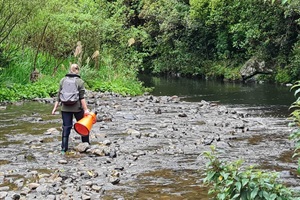Summer swim spot monitoring gets underway
Published on 02 November 2022

Horizons Regional Council media release
Horizons Regional Council are beginning their summer swim spot monitoring programme so that everyone in the region can check the water quality of their favourite site before they head out.
Every year from 1 November to 30 April Horizons visits approximately 80 sites across the region to collect samples which go to an independent laboratory for testing. Results are uploaded to lawa.org.nz weekly for the public to check before hopping in.
Environmental monitoring scientist Kelly Le Quesne says the team monitors the levels of faecal indicator bacteria and potentially toxic algae (cyanobacteria) in the water.
“Faecal contamination in water is measured by testing for E.coli at freshwater sites and Enterococci at coastal sites,” she says.
“The presence of these bacteria in waterways suggests that other pathogens, that are harmful to humans, may also be present. E.coli and Enterococci are not visible to the human eye so the team take samples and send them to an independent lab for processing.
“Potentially toxic algae includes cyanobacteria which appears as black mats on rocks in rivers and as green scum in and above water in lakes. This algae can be toxic to dogs, as well as humans.
“Staff observe these algae onsite using a bathyscope (underwater viewer) in rivers. In lakes a sample of the water is taken and examined under a microscope.
“Coming into contact with water where these organisms are present in sufficient quantities can lead to conditions such as gastroenteritis, respiratory illness, and ear and skin infections. Once we get the results we update LAWA so people know which sites are suitable for swimming.”
Ms Le Quesne says while the public should always check LAWA for water quality results, there are other things swimmers should be aware of, particularly around rivers.
“If it has been raining heavily within the last 72 hours please stay out of the water,” she says.
“The flow is often faster than usual and there can be high levels of faecal contamination which could make swimmers unwell. Once you’re back at your local swim spot it is also important to remember that things may have changed beneath the surface since you last swam there.
“New Zealand rivers and beaches can be unpredictable and deceptively powerful, so don’t enter the water alone, actively supervise children, and if you aren’t a confident swimmer stay out. We also recommend checking the water is clear and there’s no large debris around.
“Finally, don’t swim close to cliff faces and in an emergency call 111. Last summer our region experienced water related tragedies, so it is important that we all remember this key safety information.
“To assist with that Horizons are in the process of updating signage at our swim spots to highlight safe water practices. For anyone who wants further information about how to keep themselves and their whānau safe in and around our rivers and beaches, see Water Safety NZ.”
Ms Le Quesne says LAWA holds water quality information for swim spots around the country. Interactive maps show each of the swim spots tagged by a red, amber or green location marker to indicate that week’s results and whether the water quality is appropriate for swimming based on the Ministry of Health’s guidelines.
“This means that even if someone is heading away, they can still use the website to check results or find swim spots. Sites tested tend to be the most popular in an area, which is how most of our spots got selected.
“However, this summer we will also be asking people to provide feedback on the sites we monitor and whether we should consider alternatives. Keep an eye out on our social media accounts or freshwater.horizons.govt.nz over the next month for more information about this.”
Image: A swim spot staff member monitoring cyanobacteria using a bathyscope